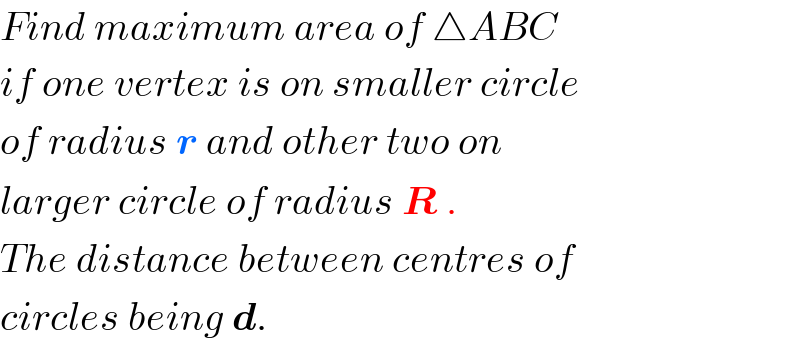
Question and Answers Forum
Question Number 36590 by ajfour last updated on 03/Jun/18

Commented by ajfour last updated on 03/Jun/18

Answered by ajfour last updated on 03/Jun/18
![△=(1/2)(x+d+r)(√(R^2 −x^2 )) (d△/dx)=((√(R^2 −x^2 ))/2)−((x(x+d+r))/(2(√(R^2 −x^2 )))) =0 ⇒ R^2 −x^2 =x^2 +x(d+r) 2x^2 +(d+r)x−R^2 =0 x=(((√((d+r)^2 +8R^2 ))−(d+r))/4) △_(max) =(1/2)[(((√((d+r)^2 +8R^2 ))+3(d+r))/4)] ×(√(R^2 −((((√((d+r)^2 +8R^2 ))−(d+r))/4))^2 )) .](Q36592.png)
Commented by MrW3 last updated on 11/Jun/18
������
| ||
Question and Answers Forum | ||
Question Number 36590 by ajfour last updated on 03/Jun/18 | ||
 | ||
Commented by ajfour last updated on 03/Jun/18 | ||
 | ||
Answered by ajfour last updated on 03/Jun/18 | ||
![△=(1/2)(x+d+r)(√(R^2 −x^2 )) (d△/dx)=((√(R^2 −x^2 ))/2)−((x(x+d+r))/(2(√(R^2 −x^2 )))) =0 ⇒ R^2 −x^2 =x^2 +x(d+r) 2x^2 +(d+r)x−R^2 =0 x=(((√((d+r)^2 +8R^2 ))−(d+r))/4) △_(max) =(1/2)[(((√((d+r)^2 +8R^2 ))+3(d+r))/4)] ×(√(R^2 −((((√((d+r)^2 +8R^2 ))−(d+r))/4))^2 )) .](Q36592.png) | ||
| ||
Commented by MrW3 last updated on 11/Jun/18 | ||
������ | ||